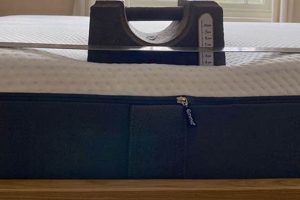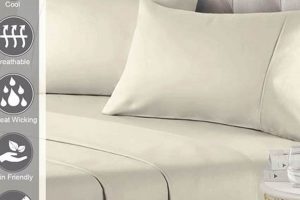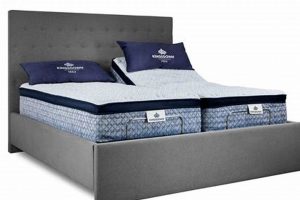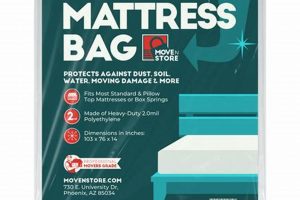This oversized bedding solution offers significantly more sleeping surface than a standard king-size mattress. Measuring approximately 80 inches wide by 98 inches long, it provides ample space for multiple sleepers, pets, or individuals who simply prefer extra room to stretch out during the night. For example, a family sharing a bed might find this enlarged format a more comfortable arrangement.
The enhanced dimensions contribute to improved sleep quality by minimizing disturbances caused by a partner’s movements. Its size accommodates taller individuals comfortably, preventing feet from hanging off the end. Historically, demand for larger mattress sizes has correlated with increases in average height and a greater emphasis on personal comfort and sleep optimization.
The remainder of this document will address key considerations when selecting a mattress of this type, including material composition, support systems, compatibility with bedroom dimensions, and long-term maintenance practices to ensure lasting comfort and value.
Considerations for Selecting Oversized Bedding
Selecting an appropriately sized sleeping surface requires careful planning and assessment of individual needs. These guidelines will assist in making an informed decision regarding an extra-large mattress purchase.
Tip 1: Room Dimensions Assessment: Measure the intended bedroom space meticulously. The bed frame, headboard, and surrounding furniture must fit comfortably, leaving adequate walking space to prevent obstruction and ensure maneuverability. A cramped environment negates the benefits of increased sleeping space.
Tip 2: Support System Evaluation: Analyze the internal coil system or foam density. Heavier individuals or couples require a robust support structure to prevent sagging and maintain spinal alignment. Consider pocketed coils or high-density foam for optimal support and motion isolation.
Tip 3: Material Composition Review: Evaluate the material composition for breathability and temperature regulation. Memory foam can retain heat, potentially causing discomfort for some sleepers. Latex or hybrid mattresses often offer better airflow, minimizing heat buildup during the night.
Tip 4: Weight Considerations: A large mattress is significantly heavier than standard sizes. Ensure the bed frame and flooring can adequately support the weight of the mattress and its occupants. Reinforce the frame if necessary to prevent structural failure.
Tip 5: Custom Bedding Sourcing: Standard bedding sizes will not fit an oversized mattress. Plan to purchase custom-made sheets, comforters, and blankets to ensure proper coverage and fit. Factor the additional cost of these specialty items into the overall budget.
Tip 6: Delivery and Setup Logistics: Transporting and maneuvering an extra-large mattress can be challenging. Confirm delivery options with the retailer, and ensure sufficient manpower is available to move the mattress into the bedroom without causing damage to the mattress or the home.
Tip 7: Firmness Level Selection: Determine the preferred firmness level based on sleeping position and personal preference. Side sleepers typically benefit from a softer surface to alleviate pressure points, while back and stomach sleepers often require a firmer surface for optimal spinal support.
Careful attention to these factors will promote a comfortable and supportive sleep environment. Overlooking these considerations may result in discomfort, increased expenses, and eventual dissatisfaction with the investment.
The subsequent sections will provide guidance on proper maintenance and care techniques to extend the lifespan and preserve the integrity of this oversized sleeping surface.
1. Spaciousness
Spaciousness, in the context of oversized bedding, directly relates to the enhanced freedom of movement and reduced sleep disturbance experienced by users. Its relevance is particularly pronounced when considering the dimensions of a large mattress.
- Enhanced Freedom of Movement
The significantly expanded surface area accommodates a wider range of sleeping positions and movements without encroaching upon a partner’s space. For example, individuals who frequently change positions during the night benefit from the unrestricted mobility afforded by the increased width and length.
- Reduced Sleep Disturbance
Greater personal space minimizes the transmission of movement between sleeping partners. This is particularly relevant for couples where one partner is restless or prone to tossing and turning. The expansive surface effectively isolates motion, promoting uninterrupted sleep for both individuals.
- Accommodation of Multiple Sleepers
The generous dimensions comfortably accommodate multiple sleepers, including children or pets, without compromising individual sleep quality. Families who co-sleep or individuals who share their bed with pets will find the additional space beneficial in preventing overcrowding and discomfort.
- Improved Temperature Regulation
Increased personal space allows for better air circulation around the body, potentially mitigating overheating during sleep. This is particularly advantageous for individuals who tend to sleep hot or live in warmer climates. Reduced body contact with a sleeping partner also contributes to improved temperature regulation.
These facets collectively demonstrate how spaciousness translates into tangible benefits for users of large bedding solutions, offering an improved sleep environment characterized by enhanced comfort, reduced disturbance, and greater individual freedom. The increased surface area directly contributes to a more restful and restorative sleep experience.
2. Dimensions
Dimensions are a defining characteristic of oversized bedding solutions, dictating both the physical footprint and functional capacity of the product. In the context of a “texas king mattress”, dimensions are paramount, differentiating it from standard mattress sizes and influencing its suitability for specific bedrooms and user needs. Specifically, the approximately 80 inches width and 98 inches length, compared to a standard king’s 76 inches width and 80 inches length, results in a significantly larger sleeping surface. This increased area directly impacts the bed’s ability to comfortably accommodate multiple sleepers, taller individuals, or those who prefer ample personal space. Failure to consider these dimensions relative to bedroom size can lead to logistical challenges, as maneuvering the mattress and fitting it within the room becomes more difficult. Therefore, dimensions function as a critical determinant in the selection process, impacting user satisfaction and practical usability.
The practical significance of understanding these dimensions extends beyond mere spati
al considerations. It also influences the type and quantity of bedding required. Standard-sized sheets, blankets, and comforters are invariably inadequate for a “texas king mattress,” necessitating the acquisition of custom-made or oversized linens. This increases the overall cost of ownership. Furthermore, the dimensions directly affect the weight and structural integrity of the mattress. A larger mattress requires a robust frame and foundation capable of supporting the increased weight and preventing sagging. For example, a family that purchases the bedding solution without assessing the strength of their existing bed frame may find the frame buckles under the strain, leading to premature mattress wear and potentially causing structural damage. Thus, accurate assessment of the dimensions is essential for ensuring appropriate support and preventing costly replacements.
In summary, the dimensions of a “texas king mattress” are intrinsically linked to its functionality, suitability, and overall value. They dictate the level of comfort offered, the logistical challenges involved in installation, and the ancillary costs associated with bedding and support infrastructure. A thorough understanding of these dimensional considerations is crucial for making an informed purchasing decision and maximizing the long-term benefits of the product. Overlooking these aspects can result in dissatisfaction, financial strain, and ultimately, a suboptimal sleep experience.
3. Support
Adequate support is paramount in an extra-large mattress due to its expansive surface area and increased potential for weight distribution imbalances. A poorly supported mattress will sag prematurely, leading to discomfort, spinal misalignment, and reduced sleep quality. This effect is amplified in larger formats, where the unsupported area can create a “hammock” effect, forcing sleepers to roll towards the center. For instance, a couple sleeping on a mattress with insufficient internal support may experience constant pressure and discomfort, resulting in restless sleep and long-term back pain.
The internal support system directly impacts the mattress’s longevity and its ability to maintain its intended shape over time. Mattress support can be achieved through various methods, including innerspring coils, foam cores, or hybrid constructions utilizing both. Each support system offers distinct characteristics: innerspring systems provide responsive support and airflow, while foam cores offer contouring and motion isolation. Hybrid systems aim to combine the benefits of both. The choice of support system depends on individual preferences, sleeping positions, and body weight. In a scenario where two individuals of significantly different weights share the extra-large bed, a zoned support system, offering varying firmness levels across different regions of the mattress, becomes particularly relevant.
In conclusion, support is a critical element of mattress design, especially for oversized models, influencing comfort, durability, and long-term value. Neglecting the support system during the selection process can result in a suboptimal sleep environment and premature mattress failure. Prioritizing a robust and appropriate support system is an investment in sleep quality and long-term spinal health.
4. Materials
The selection of materials directly influences the performance and longevity of an oversized mattress. Due to the increased surface area and volume of a mattress, material choices become proportionally more critical. Inferior materials will exhibit wear and tear more rapidly than in standard-sized mattresses. The types of foam used, the coil gauge in innerspring systems, and the fabric covering all contribute to the overall support, comfort, and durability of the mattress. For example, low-density memory foam may compress and lose its shape prematurely under the weight of multiple sleepers, while a high-quality latex foam will maintain its resilience for a longer period.
The breathability and temperature regulation properties are also significantly affected by material selection. A mattress constructed with non-breathable materials can trap heat, leading to discomfort and disrupted sleep. Conversely, materials such as organic cotton, wool, or open-cell foam promote airflow, creating a cooler and more comfortable sleeping environment. The impact of these materials is further amplified in a larger mattress, where greater body surface area comes into contact with the sleeping surface. Furthermore, the hypoallergenic properties of the mattress are determined by its material composition. Individuals with allergies or sensitivities benefit from mattresses made with natural or hypoallergenic materials, such as latex or certified organic cotton, which minimize exposure to allergens and irritants.
In summary, the relationship between materials and oversized bedding is one of direct cause and effect. The quality of materials directly impacts the mattress’s support, comfort, durability, and overall performance. While cost may be a factor, opting for higher-quality materials is a prudent investment in long-term sleep quality and the lifespan of the mattress. Therefore, a thorough evaluation of the material composition is an essential step in selecting a suitable oversized sleep solution.
5. Longevity
The expected lifespan of a mattress is directly influenced by its increased dimensions and the potential for greater stress distribution compared to standard sizes. Several factors contribute to this: material quality, construction techniques, frequency of use, and maintenance practices. Inadequate material quality, such as low-density foam or weak coil systems, will exhibit compression and degradation at an accelerated rate due to the increased surface area and potential for concentrated weight. A mattress constructed using durable, high-quality materials, such as high-density latex or individually wrapped coils, can withstand greater stress and maintain its structural integrity for a longer period. For instance, a family consistently using the mattress will exert more wear and tear than a single individual, reducing the lifespan if construction and materials are substandard.
Proper maintenance and care significantly impact the durability. Regular rotation and flipping (if applicable to the specific mattress design) distribute wear evenly across the surface, preventing localized sagging. The use of a mattress protector safeguards against spills, stains, and dust mites, which can degrade the materials over time. Ignoring such preventative measures can lead to premature deterioration and compromise the structural integrity. For example, neglecting to protect against moisture infiltration can foster mold growth within the mattress core, severely affecting its hygiene and reducing its lifespan significantly. Conversely, diligent application of these practices contributes to the preservation of its structural integrity and extends its usability.
Ultimately, the longevity of a mattress is a crucial consideration when evaluating its overall value proposition. While the initial investment may be higher for a mattress constructed with superior materials and design, the extended lifespan can offset this cost over time. A short-lived mattress, regardless of its initial price, represents a less efficient investment due to the
need for frequent replacement. Therefore, a holistic assessment of material quality, construction techniques, maintenance requirements, and expected lifespan is essential for making an informed purchasing decision and maximizing the long-term benefits of a enhanced-size sleep surface.
6. Investment
The financial outlay associated with acquiring a Texas King mattress transcends the simple act of purchase; it constitutes a multi-faceted investment in long-term well-being and sleep quality. This section elucidates the various components and implications of this investment.
- Initial Acquisition Cost
The primary factor is the initial purchase price, which is typically higher than standard mattress sizes due to the increased material requirements and specialized manufacturing processes. For instance, a high-quality mattress of this size may cost significantly more than a standard queen or king. This initial cost represents a significant upfront investment that must be weighed against the potential benefits.
- Ancillary Expenses
Beyond the mattress itself, additional expenses arise from the need for custom-sized bedding, including sheets, comforters, and bed frames capable of supporting the larger dimensions. These ancillary costs contribute to the overall financial commitment. Standard bedding sizes are not compatible, necessitating bespoke solutions that add to the total investment.
- Long-Term Health Benefits
The investment in a comfortable, supportive mattress can yield long-term health benefits by promoting restful sleep, reducing back pain, and minimizing sleep disturbances. Improved sleep quality can translate to increased productivity, enhanced cognitive function, and reduced healthcare costs. This aspect of the investment focuses on the tangible and intangible improvements to overall health and well-being derived from a superior sleep environment.
- Durability and Replacement Cycle
A higher initial investment in a quality mattress often translates to increased durability and a longer replacement cycle. While cheaper options may be tempting, they often require more frequent replacement, negating any initial cost savings. Investing in a durable mattress reduces the long-term costs associated with replacement, making it a more economically sound choice over time.
These facets collectively illustrate the comprehensive nature of the investment in a Texas King mattress. The initial cost, ancillary expenses, long-term health benefits, and durability all contribute to the overall value proposition. A thorough evaluation of these factors is essential for making an informed purchasing decision and maximizing the return on investment in terms of sleep quality and long-term well-being.
Frequently Asked Questions about Texas King Mattresses
The following questions address common concerns and provide detailed information regarding this specialized bedding type.
Question 1: What are the precise dimensions of a Texas King mattress?
A Texas King mattress typically measures approximately 80 inches in width and 98 inches in length. These dimensions exceed those of a standard King mattress.
Question 2: Are standard-sized sheets compatible with a Texas King mattress?
No, standard-sized sheets are not adequately sized for a Texas King mattress. Custom-made or oversized sheets are required to ensure proper coverage and fit.
Question 3: What type of bed frame is necessary to support a Texas King mattress?
A reinforced bed frame is essential to adequately support the weight of a Texas King mattress and its occupants. The frame should be designed to prevent sagging and ensure stability.
Question 4: How does the cost of a Texas King mattress compare to that of a standard King mattress?
The cost of a Texas King mattress is generally higher than that of a standard King mattress due to the increased material requirements and specialized manufacturing processes.
Question 5: Are there specific considerations for moving a Texas King mattress?
Yes, moving a Texas King mattress requires careful planning and sufficient manpower. Due to its size and weight, professional moving assistance may be necessary to prevent damage to the mattress or the surrounding environment.
Question 6: What are the potential benefits of choosing a Texas King mattress over a standard King mattress?
Potential benefits include increased sleeping space, reduced sleep disturbance, and improved comfort for taller individuals or couples who prefer ample personal space. These benefits contribute to enhanced sleep quality and overall well-being.
These responses offer a comprehensive overview of key considerations surrounding this unique mattress size.
The next section will provide information regarding sourcing and purchasing this specialized bedding solution.
Conclusion
This exploration has elucidated the defining characteristics and considerations surrounding the “texas king mattress.” The analysis encompassed dimensions, support systems, material composition, longevity, and the overall investment involved. It is demonstrably clear that this oversized bedding solution presents both advantages and challenges, necessitating careful evaluation prior to purchase.
Potential buyers are encouraged to meticulously assess their spatial requirements, budgetary constraints, and support system preferences before committing to this specialized product. A well-informed decision ensures optimal sleep quality and long-term satisfaction, solidifying the mattress as a beneficial investment rather than a costly misstep. Future innovations in material science and manufacturing techniques may further enhance the appeal and practicality of this unique sleeping solution, expanding its relevance in the bedding market.



![Best King Medium Mattress [Guide] - Sleep Like a King! Organic & Natural Mattress Buyer’s Guide: Non-Toxic Sleep Solutions Best King Medium Mattress [Guide] - Sleep Like a King! | Organic & Natural Mattress Buyer’s Guide: Non-Toxic Sleep Solutions](https://mattressworldpa.com/wp-content/uploads/2025/07/th-8153-300x200.jpg)



![Best California King Hybrid Mattress [Guide & Reviews] Organic & Natural Mattress Buyer’s Guide: Non-Toxic Sleep Solutions Best California King Hybrid Mattress [Guide & Reviews] | Organic & Natural Mattress Buyer’s Guide: Non-Toxic Sleep Solutions](https://mattressworldpa.com/wp-content/uploads/2025/07/th-8149-300x200.jpg)